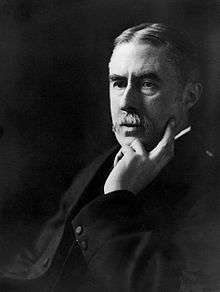A. E. Housman
Alfred Edward Housman (/ˈhaʊsmən/; 26 March 1859 – 30 April 1936), usually known as A. E. Housman, was an English classical scholar and poet, best known to the general public for his cycle of poems A Shropshire Lad. Lyrical and almost epigrammatic in form, the poems wistfully evoke the dooms and disappointments of youth in the English countryside.[1] Their beauty, simplicity and distinctive imagery appealed strongly to Edwardian taste, and to many early 20th-century English composers both before and after the First World War. Through their song-settings, the poems became closely associated with that era, and with Shropshire itself.
A. E. Housman | |
|---|---|
 Photo portrait by E. O. Hoppé, 1910 | |
| Born | Alfred Edward Housman 26 March 1859 Bromsgrove, Worcestershire, England |
| Died | 30 April 1936 (aged 77) Cambridge, England |
| Pen name | A. E. Housman |
| Occupation | Classicist and poet |
| Nationality | British |
| Alma mater | St John's College, Oxford |
| Genre | Lyric poetry |
| Notable works | A Shropshire Lad |
| Relatives | Clemence Housman, Laurence Housman |
Housman was one of the foremost classicists of his age and has been ranked as one of the greatest scholars who ever lived.[2][3] He established his reputation publishing as a private scholar and, on the strength and quality of his work, was appointed Professor of Latin at University College London and then at the University of Cambridge. His editions of Juvenal, Manilius and Lucan are still considered authoritative.
Life



The eldest of seven children, Housman was born at Valley House in Fockbury, a hamlet on the outskirts of Bromsgrove in Worcestershire, to Sarah Jane (née Williams, married 17 June 1858 in Woodchester, Gloucester)[4] and Edward Housman (whose family came from Lancaster), and was baptised on 24 April 1859 at Christ Church, in Catshill.[5][6][7] His mother died on his twelfth birthday, and his father, a country solicitor, remarried, to an elder cousin, Lucy, in 1873. Two of his siblings became prominent writers, sister Clemence Housman and brother Laurence Housman.
Housman was educated at King Edward's School in Birmingham and later Bromsgrove School, where he revealed his academic promise and won prizes for his poems.[7][8] In 1877 he won an open scholarship to St John's College, Oxford, and went there to study classics.[7] Although introverted by nature, Housman formed strong friendships with two roommates, Moses John Jackson (1858 – 14 January 1923) and A. W. Pollard. Though Housman obtained a first in classical Moderations in 1879, his dedication to textual analysis led him to neglect the ancient history and philosophy that formed part of the Greats curriculum. Accordingly, he failed his Finals and had to return humiliated in Michaelmas term to resit the exam and at least gain a lower-level pass degree.[9][7] Though some attribute Housman's unexpected performance in his exams directly to his unrequited feelings for Jackson,[10] most biographers adduce more obvious causes. Housman was indifferent to philosophy and overconfident in his exceptional gifts, and he spent too much time with his friends. He may also have been distracted by news of his father's desperate illness.[11][12][13]

After Oxford, Jackson went to work as a clerk in the Patent Office in London and arranged a job there for Housman too.[7] The two shared a flat with Jackson's brother Adalbert until 1885, when Housman moved to lodgings of his own, probably after Jackson responded to a declaration of love by telling Housman that he could not reciprocate his feelings.[14] Two years later, Jackson moved to India, placing more distance between himself and Housman. When he returned briefly to England in 1889, to marry, Housman was not invited to the wedding and knew nothing about it until the couple had left the country. Adalbert Jackson died in 1892 and Housman commemorated him in a poem published as "XLII – A.J.J." of More Poems (1936).
Meanwhile, Housman pursued his classical studies independently, and published scholarly articles on Horace, Propertius, Ovid, Aeschylus, Euripides and Sophocles.[7] He also completed an edition of Propertius, which however was rejected by both Oxford University Press and Macmillan in 1885, and was destroyed after his death. He gradually acquired such a high reputation that in 1892 he was offered and accepted the professorship of Latin at University College London (UCL).[7] When, during his tenure, an immensely rare Coverdale Bible of 1535 was discovered in the UCL library and presented to the Library Committee, Housman (who had become an atheist while at Oxford)[15] remarked that it would be better to sell it to "buy some really useful books with the proceeds".[16]
Although Housman's early work and his responsibilities as a professor included both Latin and Greek, he began to specialise in Latin poetry. When asked later why he had stopped writing about Greek verse, he responded, "I found that I could not attain to excellence in both."[17] In 1911 he took the Kennedy Professorship of Latin at Trinity College, Cambridge, where he remained for the rest of his life. G. P. Goold, Classics Professor at University College, wrote of Housman's accomplishments:
The legacy of Housman's scholarship is a thing of permanent value; and that value consists less in obvious results, the establishment of general propositions about Latin and the removal of scribal mistakes, than in the shining example he provides of a wonderful mind at work … He was and may remain the last great textual critic.[3]
Between 1903 and 1930 Housman published his critical edition of Manilius's Astronomicon in five volumes. He also edited works by Juvenal (1905) and Lucan (1926).
Many colleagues were unnerved by his scathing attacks on those he thought guilty of shoddy scholarship.[7] In his paper "The Application of Thought to Textual Criticism" (1921) Housman wrote: "A textual critic engaged upon his business is not at all like Newton investigating the motion of the planets: he is much more like a dog hunting for fleas." He declared many of his contemporary scholars to be stupid, lazy, vain, or all three, saying: "Knowledge is good, method is good, but one thing beyond all others is necessary; and that is to have a head, not a pumpkin, on your shoulders, and brains, not pudding, in your head."[3][18]
His younger colleague A. S. F. Gow quoted examples of these attacks, noting that they "were often savage in the extreme".[19] Gow also related how Housman intimidated students, sometimes reducing the women to tears. According to Gow, Housman could never remember the names of female students, maintaining that "had he burdened his memory by the distinction between Miss Jones and Miss Robinson, he might have forgotten that between the second and fourth declension". Among the more notable students at his Cambridge lectures was Enoch Powell,[20] one of whose own Classical emendations was later complimented by Housman.[21]

In his private life Housman enjoyed country walks, gastronomy, air travel and making frequent visits to France, where he read "books which were banned in Britain as pornographic".[22] But he struck A. C. Benson, a fellow don, as being "descended from a long line of maiden aunts".[23] His feelings about his poetry were ambivalent and he certainly treated it as secondary to his scholarship. He did not speak in public about his poems until 1933, when he gave a lecture "The Name and Nature of Poetry", arguing there that poetry should appeal to emotions rather than to the intellect.
Housman died, aged 77, in Cambridge. His ashes are buried just outside St Laurence's Church, Ludlow, Shropshire. A cherry tree was planted there in his memory (see A Shropshire Lad II) and replaced by the Housman Society in 2003 with a new cherry tree nearby.[7][24]
Poetry
A Shropshire Lad
Loveliest of trees, the cherry now
Is hung with bloom along the bough,
And stands about the woodland ride
Wearing white for Eastertide.
Now, of my threescore years and ten,
Twenty will not come again,
And take from seventy springs a score,
It only leaves me fifty more.
And since to look at things in bloom
Fifty springs are little room,
About the woodlands I will go
To see the cherry hung with snow.[25]
—A Shropshire Lad:
"Loveliest of trees, the cherry now"
During his years in London, Housman completed A Shropshire Lad, a cycle of 63 poems. After one publisher had turned it down, he helped subsidise its publication in 1896. At first selling slowly, it rapidly became a lasting success. Its appeal to English musicians had helped to make it widely known before World War I, when its themes struck a powerful chord with English readers. The book has been in print continuously since May 1896.[26]
The poems are marked by pessimism and preoccupation with death, without religious consolation (Housman had become an atheist while still an undergraduate). Housman wrote many of them while living in Highgate, London, before ever visiting Shropshire, which he presented in an idealised pastoral light as his 'land of lost content'.[27] Housman himself acknowledged that "No doubt I have been unconsciously influenced by the Greeks and Latins, but [the] chief sources of which I am conscious are Shakespeare's songs, the Scottish Border ballads, and Heine."[28]
Later collections
Housman began collecting a new set of poems after the First World War. His early work was an influence on many British poets who became famous by their writing about the war, and he himself wrote several poems as occasional verse to commemorate the war dead. This included his Epitaph on an Army of Mercenaries, honouring the British Expeditionary Force, an elite but small force of professional soldiers sent to Belgium at the start of the war. In the early 1920s, when Moses Jackson was dying in Canada, Housman wanted to assemble his best unpublished poems so that Jackson could read them before his death.[7] These later poems, mostly written before 1910, show a greater variety of subject and form than those in A Shropshire Lad but lack its consistency. He published his new collection as Last Poems (1922), feeling that his inspiration was exhausted and that he should not publish more in his lifetime.
After Housman's death in 1936, his brother, Laurence published further poems in More Poems (1936), A. E .H.: Some Poems, Some Letters and a Personal Memoir by his Brother (1937), and Collected Poems (1939). A. E. H. includes humorous verse such as a parody of Longfellow's poem Excelsior. Housman also wrote a parodic Fragment of a Greek Tragedy, in English, published posthumously with humorous poems under the title Unkind to Unicorns.[29]
John Sparrow quoted a letter written late in Housman's life that described the genesis of his poems:
Poetry was for him …'a morbid secretion', as the pearl is for the oyster. The desire, or the need, did not come upon him often, and it came usually when he was feeling ill or depressed; then whole lines and stanzas would present themselves to him without any effort, or any consciousness of composition on his part. Sometimes they wanted a little alteration, sometimes none; sometimes the lines needed in order to make a complete poem would come later, spontaneously or with 'a little coaxing'; sometimes he had to sit down and finish the poem with his head. That... was a long and laborious process.[30]
Sparrow himself adds, "How difficult it is to achieve a satisfactory analysis may be judged by considering the last poem in A Shropshire Lad. Of its four stanzas, Housman tells us that two were 'given' him ready made; one was coaxed forth from his subconsciousness an hour or two later; the remaining one took months of conscious composition. No one can tell for certain which was which."[30]
De Amicitia (Of Friendship)
In 1942 Laurence Housman also deposited an essay entitled "A. E. Housman's 'De Amicitia'" (there is a link to the text, below in this article, under "Further reading") in the British Library, with the proviso that it was not to be published for 25 years. The essay discussed A. E. Housman's homosexuality and his love for Moses Jackson.[31] Despite the conservative nature of the times and his own caution in public life, Housman was quite open in his poetry, and especially in A Shropshire Lad, about his deeper sympathies. Poem XXX of that sequence, for instance, speaks of how "Fear contended with desire": "Others, I am not the first, / Have willed more mischief than they durst". In More Poems, he buries his love for Moses Jackson in the very act of commemorating it, as his feelings of love are not reciprocated and must be carried unfulfilled to the grave:[32]
Because I liked you better
Than suits a man to say,
It irked you, and I promised
To throw the thought away.
To put the world between us
We parted, stiff and dry;
"Good-bye," said you, "forget me."
"I will, no fear," said I.
If here, where clover whitens
The dead man's knoll, you pass,
And no tall flower to meet you
Starts in the trefoiled grass,
Halt by the headstone naming
The heart no longer stirred,
And say the lad that loved you
Was one that kept his word.[33]
His poem "Oh who is that young sinner with the handcuffs on his wrists?", written after the trial of Oscar Wilde, addressed more general attitudes towards homosexuals.[34] In the poem the prisoner is suffering "for the colour of his hair", a natural quality that, in a coded reference to homosexuality, is reviled as "nameless and abominable" (recalling the legal phrase peccatum illud horribile, inter Christianos non nominandum, "that horrible sin, not to be named amongst Christians").
Housman song settings
Housman's poetry, especially A Shropshire Lad, was set to music by many British, and in particular English, composers in the first half of the 20th century. The national, pastoral and traditional elements of his style resonated with similar trends in English music.[35] In 1904 the cycle A Shropshire Lad was set by Arthur Somervell, who in 1898 had begun to develop the concept of the English song-cycle in his version of Tennyson's "Maud".[36] Stephen Banfield believes it was acquaintance with Somervell's cycle that led other composers to set Housman: Ralph Vaughan Williams is likely to have attended the first performance at the Aeolian Hall on 3 February 1905.[37] His well-known cycle of six songs On Wenlock Edge, for string quartet, tenor and piano, was published in 1909. Between 1909 and 1911 George Butterworth produced settings in two collections, Six Songs from A Shropshire Lad and Bredon Hill and Other Songs. He also wrote the orchestral tone poem A Shropshire Lad, first performed at Leeds Festival in 1912.[38]
Ivor Gurney was another composer who made renowned settings of Housman's poems. Towards the end of World War I he was working on his cycle Ludlow and Teme, for voice and string quartet (published in 1919),[39] and went on to compose the eight-song cycle The Western Playland in 1921.[40] One more who set Housman songs at this period was John Ireland in the song cycle, The Land of Lost Content (1920–21). Even composers not directly associated with the 'pastoral' tradition, such as Arnold Bax, Lennox Berkeley and Arthur Bliss, were attracted to Housman's poetry. A 1976 catalogue listed 400 musical settings of Housman's poems.[35] As of 2020, Lieder Net Archive records 615 settings of 187 texts.[41]
Commemorations
The earliest commemoration of Housman was in the chapel of Trinity College in Cambridge, where there is a memorial brass on the south wall.[42] The Latin inscription was composed by his colleague there, A. S. F. Gow, who was also the author of a biographical and bibliographical sketch published immediately following his death.[43] Translated into English, the memorial reads:
This inscription commemorates Alfred Edward Housman, who was for twenty-five years Kennedy Professor of Latin and Fellow of the College. Following in Bentley's footsteps he corrected the transmitted text of the Latin poets with so keen an intelligence and so ample a stock of learning, and chastised the sloth of editors so sharply and wittily, that he takes his place as the virtual second founder of textual studies. He was also a poet whose slim volumes of verse assured him of a secure place on the British Helicon. He died on 30th April 1936 at the age of seventy-six.[44]

From 1947, University College London's academic common room was dedicated to his memory as the Housman Room.[45] Blue plaques followed later elsewhere, the first being on Byron Cottage in Highgate in 1969, recording the fact that A Shropshire Lad was written there. More followed on his Worcestershire birthplace, his homes and school in Bromsgrove.[46] The latter were encouraged by the Housman Society, which was founded in the town in 1973.[47] Another initiative was the statue in Bromsgrove High Street, showing the poet striding with walking stick in hand. The work of local sculptor Kenneth Potts, it was unveiled on 22 March 1985.[48]
The blue plaques in Worcestershire were set up on the centenary of A Shropshire Lad in 1996. In September of the same year a memorial window lozenge was dedicated at Poets' Corner in Westminster Abbey[49] The following year saw the première of Tom Stoppard's play The Invention of Love, whose subject is the relationship between Housman and Moses Jackson.[50]
As the 150th anniversary of his birth approached, London University inaugurated its Housman lectures on classical subjects in 2005, initially given every second year then annually after 2011.[51] The anniversary itself in 2009 saw the publication of a new edition of A Shropshire Lad, including pictures from across Shropshire taken by local photographer Gareth Thomas.[52] Among other events, there were performances of Vaughan Williams' On Wenlock Edge and Gurney's Ludlow and Teme at St Laurence's Church in Ludlow.[53]
Works
Poetry collections
- A Shropshire Lad (1896)
- Last Poems (1922, Henry Holt & Company)
- A Shropshire Lad: Authorized Edition (1924, Henry Holt & Company)
- More Poems (1936, Barclays)
- Collected Poems (1940, Henry Holt & Company)
- Collected Poems (1939); the poems included in this volume but not the three above are known as Additional Poems. The Penguin edition of 1956 includes an introduction by John Sparrow.
- Manuscript Poems: Eight Hundred Lines of Hitherto Un-collected Verse from the Author's Notebooks, ed. Tom Burns Haber (1955)
- Unkind to Unicorns: Selected Comic Verse, ed. J. Roy Birch (1995; 2nd ed. 1999)
- The Poems of A. E. Housman, ed. Archie Burnett (1997)
- A Shropshire Lad and Other Poems (2010, Penguin Classics)
Classical scholarship
- P. Ovidi Nasonis Ibis (1894. In J. P. Postgate's "Corpus Poetarum Latinorum")
- M. Manilii Astronomica (1903–1930; 2nd ed. 1937; 5 vols.)
- D. Iunii Iuuenalis Saturae: editorum in usum edidit (1905; 2nd ed. 1931)
- M. Annaei Lucani, Belli Ciuilis Libri Decem: editorum in usum edidit (1926; 2nd ed. 1927)
- The Classical Papers of A. E. Housman, ed. J. Diggle and F. R. D. Goodyear (1972; 3 vols.)
- "Housman's Latin Inscriptions", William White, The Classical Journal (1955) 159–166
Published lectures
These lectures are listed by date of delivery, with date of first publication given separately if different.
- Introductory Lecture (1892)
- "Swinburne" (1910; published 1969)
- Cambridge Inaugural Lecture (1911; published 1969 as "The Confines of Criticism")
- "The Application of Thought to Textual Criticism" (1921; published 1922)
- "The Name and Nature of Poetry" (1933)
Prose collections
Selected Prose, edited by John Carter, Cambridge University Press, 1961
Collected letters
- The Letters of A. E. Housman, ed. Henry Maas (1971)
- The Letters of A. E. Housman, ed. Archie Burnett (2007)
See also
Footnotes
- "A E Housman, The Poetry Archive". Archived from the original on 12 November 2019. Retrieved 3 October 2014.
- 'a man who turned out to be not only the great English classical scholar of his time but also one of the few real and great scholars anywhere at any time'. Charles Oscar Brink, English Classical Scholarship: Historical reflections on Bentley, Porson and Housman, James Clarke & Co, Oxford, Oxford University Press, New York, 1986 p.149
- "A. E. Housman". Poetry Foundation. 28 May 2020. Retrieved 28 May 2020.
- "England Marriages, 1538–1973 for Edward Housman", Baptism record via Family Search.org
- "England Births and Christenings, 1538–1975 for Alfred Edward Housman", Baptism record via Family Search.org
- Christ Church Catshill
- Profile at Poets.org
- "Housman's 150th birthday". BBC. Retrieved 12 January 2017.
- P. G. Naiditch. "A. E. Housman at University College, London: The Election of 1892". Retrieved 31 December 2017.
- Cunningham (2000) p. 981.
- Norman Page, Macmillan, London (1983) A. E. Housman: A Critical Biography pp. 43–46
- Richard Perceval Graves, A. E. Housman: The Scholar-Poet Charles Scribners, New York (1979) pp. 52–55.
- Charles Oscar Brink, English Classical Scholarship p. 152
- Summers (1995) p. 371
- Blocksidge, Martin. A. E. Housman: A Single Life. N.p.: n.p., 2016
- Ricks, Christopher (1989). A. E. Housman. Collected Poems and Selected Prose. Harmondsworth: Penguin. p. 18.
- Gow (Cambridge 1936) p. 5
- "The Application of Thought to Textual Criticism", (1921) Housman
- Gow (Cambridge 1936) p. 24
- Gow (Cambridge 1936) p. 18
- The Letters of A. E. Housman, Clarendon Press 2007, p.333
- Graves (1979) p. 155.
- Critchley (1988).
- Wilson, Scott. Resting Places: The Burial Sites of More Than 14,000 Famous Persons, 3d ed.: 2 (Kindle Location 22231). McFarland & Company, Inc., Publishers. Kindle Edition
- Housman, A. E. (1906). A Shropshire Lad. New York: John Lane Company. pp. 3-4.
- Peter Parker, Housman Country, London 2016, Chapter 1
- A. E. Housman, A Shropshire Lad, XL
- Richard Stokes, The Penguin Book of English Song, 2016, p. li
- J. Roy Birch and Norman Page, ed. (1995). Unkind to Unicorns. Cambridge: Silent Books.
- Collected Poems Penguin, Harmondsworth (1956), preface by John Sparrow.
- Summers ed. 1995, 371.
- Summers (1995) p372.
- Housman, A. E. (1936). More Poems. New York: A. A. Knopf. pp. 44-45.
- Housman (1937) p213.
- Palmer, Christopher. 'Housman, A(lfred) E(dward)', in Grove Music Online (2001)
- 'Two Song Cycles by Arthur Somervell' in Opera Today, 2 June 2020
- Banfield, Stephen. Sensibility and English Song (1985), p 233-4
- Arthur Eaglefield Hull, A Dictionary of Modern Music and Musicians Dent, London (1924), 73.
- Kate Kennedy, "Ambivalent Englishness: Ivor Gurney's song cycle Ludlow and Teme", First World War Studies, Volume 2, 2011, – Issue 1: Literature and Music of the First World War
- "The Western Playland". The LiederNet Archive. Retrieved 28 May 2020.
- "Authors starting with the letter H". The LiederNet Archive. Retrieved 28 May 2020.
- "Brasses H-K". Trinity College Chapel. Retrieved 28 May 2020.
- A.E. Housman: Classical Scholar, Bloomsbury 2009, N. Hopkinson, "Housman and J.P. Postgate"
- In its original Latin the plaque reads: HOC TITVLO COMMEMORATVR / ALFRED EDWARD HOUSMAN [sic] / PER XXV ANNOS LINGVAE LATINAE PROFESSOR KENNEDIANVS / ET HVIVS COLLEGII SOCIVS / QVI BENTLEII INSISTENS VESTIGIIS / TEXTVM TRADITVM POETARVM LATINORVM / TANTO INGENII ACVMINE TANTIS DOCTRINAE COPIIS / EDITORVM SOCORDIAM / TAM ACRI CAVILLATIONE CASTIGAVIT / VT HORVM STVDIORVM PAENE REFORMATOR EXSTITERIT / IDEM POETA / TENVI CARMINVM FASCICVLO / SEDEM SIBI TVTAM IN HELICONE NOSTRO VINDICAVIT / OBIIT PRID.KAL.MAI./ A.S.MDCCCCXXXVI AETATIS SVAE LXXVII
- "History of the ASCR". UCL. Archived from the original on 17 February 2017. Retrieved 14 July 2017.
- "Places, subjects, or plaques matching "A. E. Housman"". Open Plaques. Retrieved 28 May 2020.
- Housman Society Newsletter 38, "Early history of the Society", pp. 7–8 Archived 1 October 2015 at the Wayback Machine
- "Statue to A. E. Housman". Public Monuments and Sculpture Association. Archived from the original on 24 September 2015. Retrieved 28 May 2020.
- "A. E. Housman". Westminster Abbey. Retrieved 28 May 2020.
- Clapp, Susannah (5 October 1997). "Susannah Clapp on Stoppard's The Invention of Love". The Observer. ISSN 0029-7712. Retrieved 28 May 2020.
- "Housman Lectures". UCL Department of Greek & Latin. 15 November 2018. Retrieved 28 May 2020.
- "A Shropshire Lad". Merlin Unwin Books. Retrieved 28 May 2020.
- "A. E. Housman: 150th birth anniversary", Shropshire Life, 21 April 2007
Sources
- Critchley, Julian, 'Homage to a lonely lad', Weekend Telegraph (UK), 23 April 1988.
- Cunningham, Valentine ed., The Victorians: An Anthology of Poetry and Poetics (Oxford: Blackwell, 2000)
- Gow, A. S. F., A. E. Housman: A Sketch Together with a List of his Writings and Indexes to his Classical Papers (Cambridge 1936)
- Graves, Richard Perceval, A.E. Housman: The Scholar-Poet (Oxford: Oxford University Press, 1979), p. 155
- Housman, Laurence, A. E .H.: Some Poems, Some Letters and a Personal Memoir by his Brother (London: Jonathan Cape, 1937)
- Page, Norman, 'Housman, Alfred Edward (1859–1936)', Oxford Dictionary of National Biography (Oxford: Oxford University Press, 2004)
- Palmer, Christopher and Stephen Banfield, 'A. E. Housman', The New Grove Dictionary of Music and Musicians (London: Macmillan, 2001)
- Richardson, Donna, "The Can Of Ail: A. E. Housman's Moral Irony", Victorian Poetry, Volume 48, Number 2, Summer 2010 (267–285)
- Shaw, Robin, "Housman's Places" (The Housman Society, 1995)
- Summers, Claude J. ed., The Gay and Lesbian Literary Heritage (New York: Henry Holt and Co., 1995)
Further reading
- Blocksidge, Martin. A. E. Housman : A Single Life (Sussex Academic Press, 2016) ISBN 978-1-84519-844-2
- Brink, C. O. Lutterworth.com, English Classical Scholarship: Historical Reflections on Bentley, Porson and Housman, James Clarke & Co (2009), ISBN 978-0-227-17299-5
- Efrati, C. The road of danger, guilt, and shame: the lonely way of A. E. Housman (Associated University Presse, 2002) ISBN 0-8386-3906-2
- Gardner, Philip, ed. A. E. Housman: The Critical Heritage, a collection of reviews and essays on Housman's poetry (London: Routledge 1992)
- Holden, A. W. and Birch, J. R. A. E Housman – A Reassessment (Palgrave Macmillan, London, 1999)
- Housman, Laurence. , De Amicitia with annotation by John Carter. Encounter (October 1967, pp. 33–40).
- Parker, Peter. Housman country : into the heart of England (Little, Brown, 2016) ISBN 978-1-4087-0613-8
External links
| Wikiquote has quotations related to: A. E. Housman |
| Wikisource has original works written by or about: Alfred Edward Housman |
| Wikimedia Commons has media related to Alfred Edward Housman. |
- Portraits of A. E. Housman at the National Portrait Gallery, London

- A. E. Housman profile and poems at Poets.org
- Profile and poems at Poetry Foundation
- London Review of Books review of "The Letters of A.E. Housman" 5 July 2007
- BBC Profile 24 June 2009
- "Star man": An article in the TLS by Robert Douglas Fairhurst, 20 June 2007
- "Lost Horizon: The sad and savage wit of A. E. Housman" New Yorker article (5 pages) by Anthony Lane 19 February 2001
- The Housman Society
- The Papers of A. E. Housman, Bryn Mawr College Special Collections
- Recording of part of the 1996 Shropshire Lad centenary reading by the Housman Society
- Catalogus Philologorum Classicorum
- Newspaper clippings about A. E. Housman in the 20th Century Press Archives of the ZBW
Works
- Works by A. E. Housman at Project Gutenberg
- Works by or about A. E. Housman at Internet Archive
- Works by A. E. Housman at LibriVox (public domain audiobooks)

- Works by A. E. Housman at Open Library
- A. E. Housman at Library of Congress Authorities, with 136 catalogue records
- Complete poems of A. E. Housman
| Academic offices | ||
|---|---|---|
| Preceded by John E. B. Mayor |
Kennedy Professor of Latin Cambridge University 1911–36 |
Succeeded by William Blair Anderson |